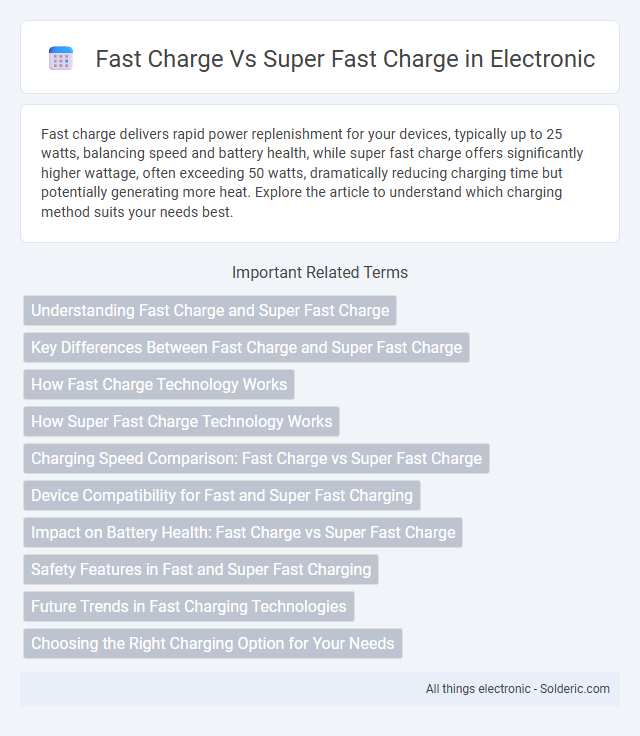Fast charge delivers rapid power replenishment for your devices, typically up to 25 watts, balancing speed and battery health, while super fast charge offers significantly higher wattage, often exceeding 50 watts, dramatically reducing charging time but potentially generating more heat. Explore the article to understand which charging method suits your needs best.
Comparison Table
| Feature | Fast Charge | Super Fast Charge |
|---|---|---|
| Charging Speed | Up to 25W | Above 25W, typically 50W to 120W+ |
| Charge Time | 30-60 minutes for 50% battery | 15-30 minutes for 50% battery |
| Device Compatibility | Widely supported by mid-range smartphones | Supported by high-end and flagship smartphones |
| Battery Impact | Moderate heat, safer for battery health | Higher heat generation, requires advanced cooling |
| Charger Requirements | Standard USB-PD or proprietary chargers | Specialized chargers and cables for higher wattage |
| Use Case | Everyday quick charging | Rapid boost charging for urgent power needs |
Understanding Fast Charge and Super Fast Charge
Fast Charge technology delivers higher current to reduce charging time compared to standard charging, typically ranging from 15W to 30W for smartphones. Super Fast Charge advances this by utilizing power outputs above 30W, often reaching 65W or more, enabling significantly quicker battery replenishment. Both technologies leverage advanced battery management systems to optimize voltage and current for safe, efficient charging.
Key Differences Between Fast Charge and Super Fast Charge
Fast Charge typically delivers power at 15-25W, enabling quick battery replenishment within 30-60 minutes, while Super Fast Charge supports higher wattages of 45W and above, drastically reducing charging time to around 15-30 minutes. The key differences lie in charging speed, power output, and heat management technologies, with Super Fast Charge systems employing advanced cooling to maintain battery health during rapid energy transfer. Compatibility with device hardware and charging protocols also differentiates these technologies, as Super Fast Charge requires specialized chargers and support for ultra-fast charging standards like USB Power Delivery 3.0 or proprietary solutions.
How Fast Charge Technology Works
Fast Charge technology increases charging speed by delivering higher current and optimized voltage regulation to your device's battery management system, which reduces the overall charging time compared to standard chargers. Super Fast Charge, an advanced version, uses even higher power output and intelligent chipset communication to quickly adapt power delivery, ensuring maximum efficiency and safety. This dynamic negotiation between charger and device accelerates energy transfer while minimizing heat generation, preserving battery health during rapid charging.
How Super Fast Charge Technology Works
Super Fast Charge technology utilizes higher wattage and advanced power management systems to deliver significantly faster charging speeds than traditional Fast Charge. It employs specialized charging protocols and optimized battery chemistry to reduce heat generation and improve energy transfer efficiency. This combination allows devices to reach full charge in a fraction of the time, enhancing user convenience and battery lifespan.
Charging Speed Comparison: Fast Charge vs Super Fast Charge
Fast Charge typically delivers power up to 25W, enabling your device to reach 50% battery in about 30 minutes, while Super Fast Charge pushes beyond 45W, reducing charging time to approximately 15-20 minutes for the same capacity. The improved power delivery in Super Fast Charge utilizes advanced protocols like USB Power Delivery PPS for more efficient and safer energy transfer. Choosing Super Fast Charge significantly enhances your device's readiness, making it ideal for users needing rapid battery replenishment.
Device Compatibility for Fast and Super Fast Charging
Fast charge technology supports a broad range of devices including most smartphones and tablets, ensuring widespread compatibility for efficient power delivery. Super fast charge, however, requires specific hardware such as advanced chargers and compatible devices from brands like Samsung or OnePlus, limiting its use to newer, high-end models. Your device must explicitly support super fast charging standards like USB Power Delivery or proprietary technologies to benefit from significantly reduced charging times.
Impact on Battery Health: Fast Charge vs Super Fast Charge
Fast charge typically delivers moderate power levels, preserving battery longevity by reducing heat generation and stress during charging cycles. Super fast charge increases charging speed significantly but may accelerate battery wear due to higher temperatures and faster chemical reactions inside the cell. To maintain your battery health, it's advisable to use super fast charging sparingly and rely on fast charging for regular use.
Safety Features in Fast and Super Fast Charging
Fast charge technology incorporates built-in safety features such as temperature control, overcurrent protection, and voltage regulation to prevent battery damage and overheating. Super fast charging enhances these safety mechanisms with advanced thermal management systems and real-time monitoring to ensure optimal charging speeds without compromising device integrity. Both technologies prioritize user safety by dynamically adjusting charging rates based on battery health and environmental conditions.
Future Trends in Fast Charging Technologies
Future trends in fast charging technologies emphasize increased power output, with super fast charge capable of delivering up to 100W or more, drastically reducing charging times compared to traditional fast charge systems typically ranging from 15W to 50W. Emerging innovations include GaN (Gallium Nitride) chargers and advanced battery management systems that enhance energy efficiency and thermal regulation, facilitating safer and more rapid power transfer. You can expect these advancements to revolutionize electric vehicle and smartphone charging, making quick top-ups more accessible and practical for everyday use.
Choosing the Right Charging Option for Your Needs
Fast charge technology typically delivers power at speeds ranging from 15 to 25 watts, making it suitable for everyday use and quick top-ups. Super fast charge options, offering 45 watts or more, are designed for users who need rapid battery replenishment, significantly cutting down wait times. Your choice between fast charge and super fast charge should depend on your device compatibility and how quickly you need your battery powered up during the day.
fast charge vs super fast charge Infographic

 solderic.com
solderic.com